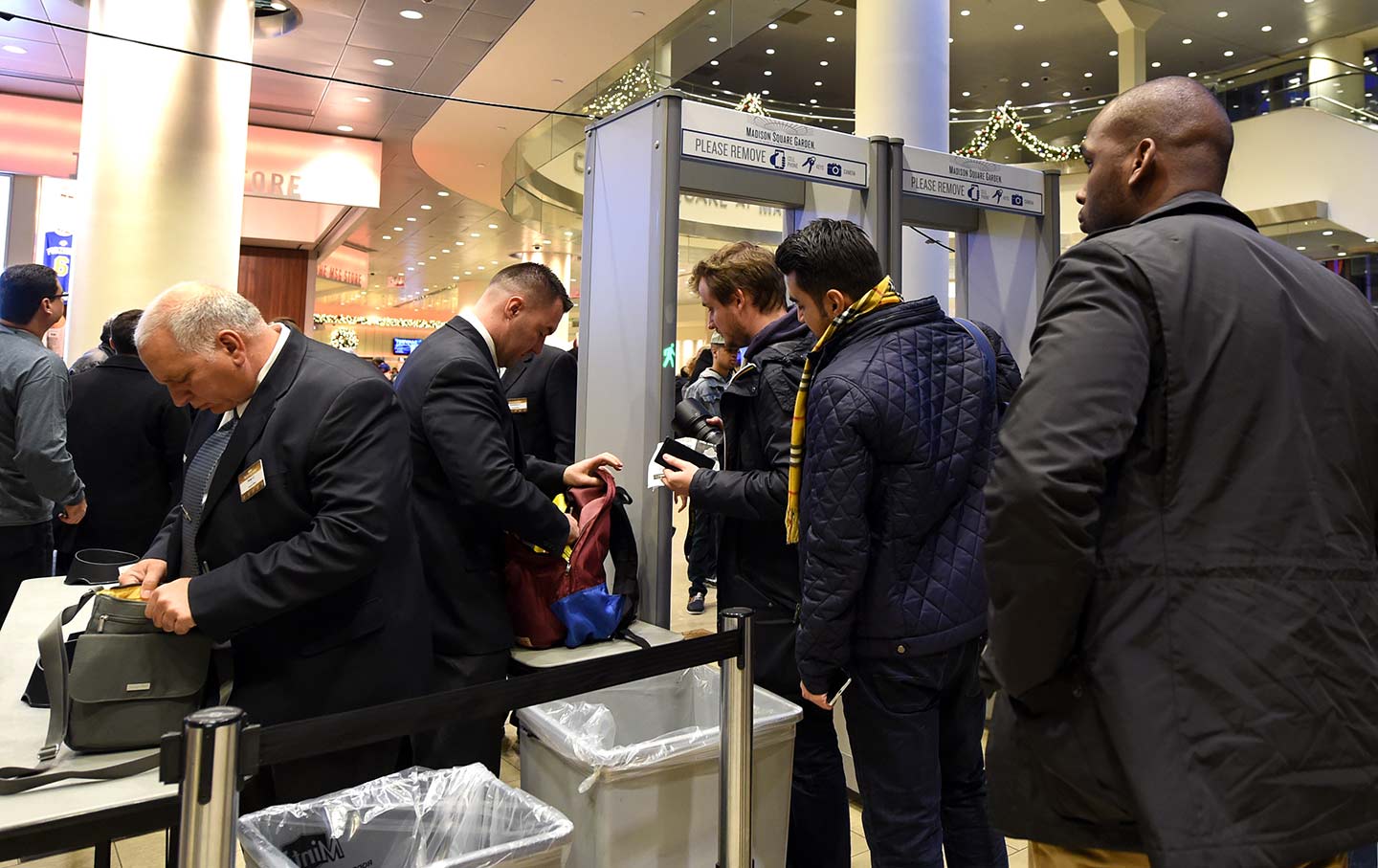
Security officials screen fans entering Madison Square Garden for a New York Knicks’ basketball game, November 2015.(AP Photo / Kathy Kmonicek)
Facial-recognition software, according to a report in The New York Times, is now being used by Madison Square Garden to seek out “threats” among fans arriving to see a game. The use of this technology, without oversight or clarity as to what it’s actually being used for, is troubling—and should be subject to far more rigorous debate than we have seen. We sought to find out who is behind this change and what it means for fans.
The NBA wouldn’t respond to our requests for comment, but referred us to the following statement from spokesperson Mike Bass: “Nothing is more important to us than the safety and security of the fans, players, team and arena staff at our games. The league and our teams are exploring the use of all state-of-the-art technology, including facial recognition, to ensure that we have industry-best security measures to protect all those in our arenas.”
The New York Knicks also wouldn’t issue a comment on behalf of the team and instead referred us to its parent corporation, the Madison Square Garden Company. A spokesperson named Kimberly Kerns said, “MSG continues to test and explore the use of new technologies to ensure we’re employing the most effective security procedures to provide a safe and wonderful experience for our guests.”
This corporate-speak isn’t good enough. The issue is more complicated than either of these parties are it making seem, and the ramifications of normalizing this kind of surveillance are extreme.
The ACLU is opposed to the use of facial recognition by corporations without the public’s awareness or consent. Jay Stanley, senior policy analyst with the ACLU Speech, Privacy, and Technology Project, said to The Nation:
Facial recognition is possibly the most powerful and dangerous biometric there is. It can be used without your knowledge, let alone your permission or participation. If you’re being fingerprinted, you know that you’re fingerprinted. There is a danger that any person can be mistaken by a computer algorithm as a dangerous person and treated as a dangerous person by security personnel. There can be questions about what lists are being run to create this algorithm—for instance, people who are banned from the stadium without necessary due process. Are they also going to put in other lists as well? Are they going to add terrorist watch lists, too? We don’t know to what extent it’s going to stir out of control. And then we get to the question of whether or not people actually will be enrolled in the facial recognition software. In other words, if I walk in, they take my picture, and run it against whatever lists they want to run and don’t get a hit—are they going to retain my photo? Are they going to use it for marketing? To try and drive more people to the hotdog stand? Are they going to try to analyze my behavior?
With MSG and the NBA now using it, Stanley says:
Facial recognition [is] moving out of a very controlled, border context and out into the wild, so as to speak. You see it being used in a commercial context. You see it being used without any of the even inadequate transparency requirements that the government is subject to because it’s a private company. [This is] in line with the trends that we’ve been seeing in recent years: businesses wanting to identify their customers and gather as much information as they can about them. This sphere of video analytics is the next frontier in that. It’s a pretty radical leap forward in surveillance.
Jeramie Scott, of the Electronic Privacy Information Center (EPIC) also said,
As large institutions begin using facial recognition on the public, it normalizes a privacy-invasive technology that lacks meaningful safeguards. The lack of regulation of facial recognition and other biometric surveillance methods means the data collected and used now for one purpose can easily be utilized for purposes not even imagined yet and without the consent from the targets of the technology. Each instant where mass surveillance is implemented, especially where little to no regulation exists like it does with facial recognition, takes us one step closer to ubiquitous surveillance and one step farther from the liberties we are suppose to hold dear.
The lack of transparency on this issue “means we don’t know for sure if Madison Square Garden is an outlier in its usage of this technology. There is no mechanism to require transparency around the use of this privacy-invasive technology.”
One thing is certain. This shouldn’t be brushed off. We either have the right to privacy or we do not. It seems already that on many fronts we’re losing that right. That’s all the more reason to stay vigilant and protect what freedoms we have left, especially that freedom articulated by Supreme Court Justice Brandeis more than a century ago: the freedom “to be let alone.”
Dave ZirinDave Zirin is the sports editor at The Nation. He is the author of 11 books on the politics of sports. He is also the coproducer and writer of the new documentary Behind the Shield: The Power and Politics of the NFL.
Andrew Tan-Delli CicchiAndrew Tan-Delli Cicchi is an editorial intern at The Nation.